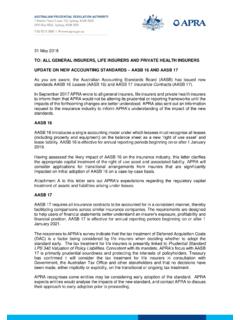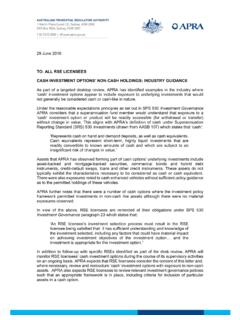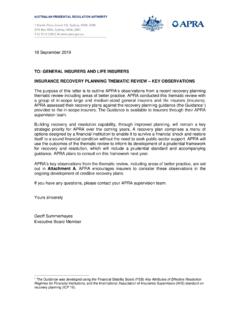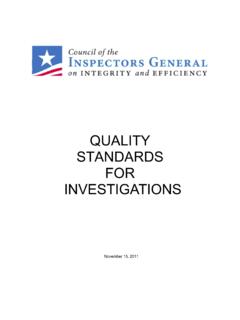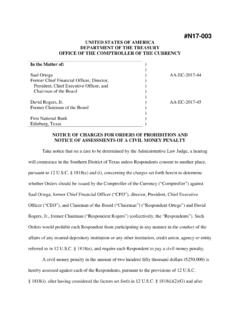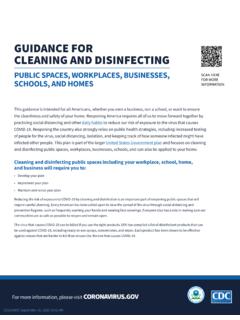Transcription of Final Prudential Standard CPS 511 Remuneration
1 Final August 2021 CPS 511 - 1 Prudential Standard CPS 511 Remuneration Objectives and key requirements of this Prudential Standard The objective of this Prudential Standard is to ensure that APRA-regulated entities maintain Remuneration arrangements which appropriately incentivise individuals to prudently manage the risks they are responsible for, and that there are appropriate consequences for poor risk outcomes. The key requirements of this Prudential Standard are that: the Board of an APRA-regulated entity is responsible for the Remuneration framework and its effective application, consistent with the size, business mix and complexity of the entity; an entity must maintain a Remuneration framework that promotes effective management of financial and non-financial risks ; Remuneration outcomes must be commensurate with performance and risk outcomes; and higher standards must be met for key roles and certain large, complex August 2021 CPS 511 - 2 Table of Contents Authority.
2 3 Application .. 3 Commencement .. 4 Interpretation .. 5 Adjustments and 6 Previous exercise of discretion .. 6 Definitions .. 6 A. Requirements for SFIs .. 9 Remuneration framework .. 9 Role of the Board .. 10 Board Remuneration Committee .. 10 Remuneration design .. 11 Deferral .. 12 Remuneration outcomes .. 13 Specified roles .. 14 Review of the Remuneration framework .. 15 Other requirements .. 15 B. Requirements for Non-SFIs .. 17 Remuneration framework .. 17 Role of the Board .. 18 Remuneration design .. 18 Remuneration outcomes .. 19 Specified roles .. 19 Other requirements .. 20 Final August 2021 CPS 511 - 3 Authority 1. This Prudential Standard is made under: (a) section 11AF of the Banking Act 1959 (Banking Act); (b) section 32 of the Insurance Act 1973 (Insurance Act); (c) section 230A of the Life Insurance Act 1995 (Life Insurance Act); (d) section 92 of the Private Health Insurance ( Prudential Supervision) Act 2015 (PHIPS Act); and (e) section 34C of the Superannuation Industry (Supervision) Act 1993 (SIS Act).
3 Application 2. Subject to paragraphs 3 and 4, this Prudential Standard applies to all APRA-regulated entities, defined as: (a) authorised deposit taking institutions (ADIs), including foreign ADIs, and non-operating holding companies authorised under the Banking Act (authorised banking NOHCs) but excluding purchased payment facility providers; (b) general insurers, including Category C insurers, non-operating holding companies authorised under the Insurance Act (authorised insurance NOHCs) and parent entities of Level 2 insurance groups; (c) life companies, including friendly societies, eligible foreign life insurance companies (EFLICs), and non-operating holding companies registered under the Life Insurance Act (registered life NOHCs); (d) private health insurers registered under the PHIPS Act.
4 And (e) registrable superannuation entity licensees (RSE licensees) under the SIS Act in respect of their business For the purposes of this Prudential Standard , an RSE licensee has the meaning given in section 10(1) of the SIS Act. An RSE licensee s business operations includes all activities of an RSE licensee (including the activities of each RSE of which it is the licensee), and all other activities of the RSE licensee to the extent that they are relevant to, or may impact on, its activities as an RSE licensee. 3. The obligations imposed by this Prudential Standard on, or in relation to, a foreign ADI, a Category C insurer or an EFLIC apply only in relation to the Australian branch operations of that entity. 4. For the purposes of this Prudential Standard , an APRA-regulated entity is either a significant financial institution or a non-significant financial institution (non- Final August 2021 CPS 511 - 4 SFI).
5 This Prudential Standard applies to these two classes of APRA-regulated entities as follows: (a) paragraphs 1 to 60 apply to any significant financial institution; and (b) paragraphs 1 to 18 and 61 to 77 apply to any non-SFI. 5. Where an entity is the Head of a group 22 Where a Level 2 group operates within a Level 3 group, a requirement expressed as applying to a Head of a group is to be read as applying to the Level 3 Head. For the avoidance of doubt, the reference to Head of a group does not apply to an RSE licensee. , it must comply with a n applicable requirement of this Prudential Standard : (a) in its capacity as an APRA-regulated entity; (b) by ensuring that a requirement is applied appropriately throughout the group, including in relation to entities that are not APRA-regulated; and (c) on a group basis.
6 6. In applying the requirements of this Prudential Standard on a group basis, references in paragraphs 16 to 77 to an APRA-regulated entity must be read as Head of a group and references to entity must be read as group . 7. This Prudential Standard does not apply to the extent it would require any entity to act (or not act) in a manner contrary to: (a) the Fair Work Act 2009; and (b) in relation to any employment contract or contract of appointment or engagement governed by foreign law, any applicable foreign legislation. 8. For an ADI, by operation of the Legislation Act 2003, this Prudential Standard is to be read and construed subject to the Banking Act, including Part IIAA which imposes requirements relating to Remuneration . Commencement 9. Subject to paragraphs 10 and 11, this Prudential Standard commences: (a) for an ADI that is a significant financial institution (whether or not the ADI is a member of any group) or a group headed by an ADI or authorised NOHC that is a significant financial institution, on 1 January 2023; (b) for a general insurer, life company, private health insurer or RSE licensee that is a significant financial institution, or a group headed by such a significant financial institution, or a group headed by an authorised NOHC, a parent entity of a Level 2 insurance group or a registered NOHC that is a significant financial institution, on 1 July 2023.
7 And Final August 2021 CPS 511 - 5 (c)for any other APRA-regulated entity, on 1 January Prudential Standard does not apply to a person s variable Remuneration if theopportunity to earn the variable Remuneration arose before the relevantcommencement dates specified in paragraph this paragraph prevents this Prudential Standard from giving rise to such an acquisition of property in relation to variable Remuneration payable under such a contract, compensation will not be payable under section 69E of the Banking Act, section 127A of the Insurance Act, section 251 of the Life Insurance Act or section 8 of the PHIPS Act. Equally, compensation would not be payable in respect of the superannuation sector noting section 349B of the SIS Act. 4A reference to a connected entity has the meaning given in section 10(1) of the SIS Act.
8 5A reference to a related body corporate has the meaning given in section 50 of the Corporations Act 2001 (Corporations Act). 6 For the avoidance of doubt, a reference to group also includes a group as defined in APS 001; For an RSE licensee, group includes where an RSE licensee is part of a corporate group. paragraph 10, if:(a)the person s variable Remuneration is payable under a contract entered intobefore this Prudential Standard came into effect; and(b) apart from this paragraph, the application of this Prudential Standard to thevariable Remuneration would result in an acquisition of property from theperson other than on just terms (within the meaning of paragraph 51(xxxi)of the Constitution);this Prudential Standard does not apply to the variable Remuneration to the extent it would result in such an Interpretation that are defined in Prudential Standard 3PS 001 Definitions, PrudentialStandard APS 001 Definitions (APS 001), Prudential Standard GPS 001 Definitions (GPS 001)
9 , Prudential Standard LPS 001 Definitions or PrudentialStandard HPS 001 Definitions appear in bold the first time they are used in thisPrudential this Prudential Standard , unless the contrary intention appears, a reference toan Act, Regulations, Rules or Prudential Standard is a reference to the Act,Regulations, Rules or Prudential Standard as in force from time to this Prudential Standard provides for APRA to exercise a power ordiscretion, the power or discretion is to be exercised in the purposes of this Prudential Standard :(a)group means a Level 2 group, Level 3 group or a group comprising theRSE licensee and all connected entities4 and all related bodies corporate5of the RSE licensee, as relevant;6(b)Head of a group means a Level 2 Head or Level 3 Head, as relevant; Final August 2021 CPS 511 - 6 (c)Level 2 group means the entities that comprise:(i)Level 2 as defined in APS 001; or(ii)a Level 2 insurance group as defined in GPS 001;(d)Level 2 Head means:(i)where an ADI that is a member of a Level 2 group is not a subsidiaryof an authorised banking NOHC or another ADI, that ADI;(ii)where an ADI that is a member of a Level 2 group is a subsidiary ofan authorised banking NOHC, that authorised banking NOHC; or(iii)the parent entity of a Level 2 insurance group as defined in GPS 001.
10 Adjustments and exclusions may adjust or exclude a specific requirement in this Prudential Standardin relation to an APRA-regulated exercise of discretion APRA-regulated entity must contact APRA if it seeks to place reliance, forthe purposes of complying with this Prudential Standard , on a previous exemptionor other exercise of discretion by APRA under Prudential Standard CPS 510 Governance or Prudential Standard SPS 510 Governance (SPS 510).Definitions following definitions are used in this Prudential Standard :(a)Board for an RSE licensee, means a reference to the Board of directors orgroup of individual trustees of an RSE licensee where group of individualtrustees has the meaning given in subsection 10(1) of the SIS Act;(b)clawback means the recovery of an amount corresponding to some or allvariable Remuneration subject to recovery that has been paid or vested to aperson;(c)conduct risk means the risk associated with misconduct;(d)executive director means a director that is not a non-executive director;(e)financial measures means measures that are based on revenue, sales,profit, the entity s share price, or other measures that directly affect these.



